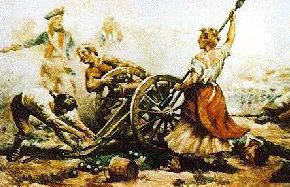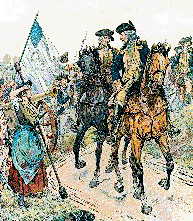The story of Molly Pitcher of American Revolution fame gives pride to her community of Carlisle, Pennsylvania, and the United States Field Artillery that claim her as its heroine. Her battleground in New Jersey boasts of a Molly Pitcher Well and a Monument dedicated to her contributions during the Battle of Monmouth. The flesh and blood woman who fought at Monmouth, May Hays McCauly, served her country well.
Because her tale has been retold many times, details conflict in different versions. In addition, assumptions in a few historical documents have led to controversy over whether the famed Molly Pitcher's real name was Mary Hays McCauly or Mary Ludwig Hays. Though many disagree, I can only conclude from research and historical documentation that the heroine Molly Pitcher was May Hays McCauly.
The Battle of Monmouth
Molly Pitcher's fame began two years after the signing of the Declaration of Independence by the American Colonies. The fight for independence had yet to take a favorable turn toward the Colonials. As the war continued, 28 June 1778 proved to be another day of fighting with stories of bravery.
Monmouth rocked with musket and gun fire. The colonial cannon line under General Stirling aimed the barrels of its guns straight down on the British Redcoats as they attempted to cross a causeway. Stirling's left-wing cannons bought time for General Washington to take command and regroup General Lee's scattered forces. The gun line met the demands of the mission.
The heat of June 1778 soared to 96 degrees as the guns barked at the British. The cannon barrels smoked, and men fell from heatstroke. In the heat, a woman walked back and forth from a well (or possibly a nearby creek) carrying water to the hot men and smoldering guns. Her husband manned one of the valuable cannons. They were making a difference by holding the causeway.
As American men fell from wounds and heat, the woman's bucket of water (or "pitcher") became precious. The men among the cannons began to call her Molly Pitcher. A large woman, she reportedly carried wounded men away from the line to shade trees as she made her trip back to the well.During one of her many returns to the line, she saw her husband fall. A Colonial officer ordered his gun moved to the rear to make room on the line; he had no one left to man it. But Molly Pitcher stepped forward to keep her husband's gun roaring - every cannon was important.
As if she had been trained for the task, Molly kept the cannon booming. The artillerymen around her noticed her swift, accurate action in keeping the gun firing. No longer were they asking for water from her; she had become one of them - a gunner. The tale of her efforts passed among the men that evening, and as each gunner spoke, the story's details changed.
Memories of Molly
Carlisle holds the memories and remains of Molly Pitcher. The "Old Graveyard" in Carlisle is where she was laid to rest with military parade but with no stone marker for her grave. All that was left of her story lived in the memories of those who had known her and a few diaries describing the Battle of Monmouth.
The citizens of Carlisle knew their heroine as Molly Pitcher, a woman who could neither read nor write. Therefore, the written accounts of Molly's contributions at Monmouth weren't by her. The written story depends on the people of Carlisle.
One such citizen recorded some of his memories of Molly Pitcher six weeks before the centennial of the Declaration of Independence. Wesley Miles recounted his time as the charge of Molly Pitcher in an article that appeared in The Carlisle Herald.
Miles' mother died when he was small. Molly had nursed his ailing mother and helped raise him after her death. He wrote, "The heroine of Monmouth, Molly Pitcher, otherwise known to us when a boy, as Molly McCauly, her real name…." He was the first to put the real name of Molly Pitcher in print. Miles continued, "The remains of the Irish woman rest in the Old Graveyard of Carlisle…Perhaps, not even a rude limestone marks her grave."
A stonecutter from town, Peter Spahr, remembered Molly McCauly. After reading Wesley Miles' article, he pursued the idea of a gravestone suggested by Miles. The community raised $100 to mark her grave, and Spahr cut the stone to mark the spot. He carved:
Molly McCauly
Renowned in History as
Mollie Pitcher
The Heroine of Monmouth
Died 1833
Aged 79 years.
Erected by the Citizens of
Cumberland County
July 4, 1876
Research later would prove that some numbers on the stone were wrong. Her death notice in the local newspaper was dated 1832. A stonecutter later corrected the date as requested by the city leaders. Tax records also showed her age of death wasn't 79. The obituary in The Carlisle Herald dated 26 January 1832 revealed her age to be 90 at her death. The stone marker did shoe, however, the citizens of Carlisle were not willing to let her story die.
The people of Carlisle returned to the grave of Molly McCauly to erect yet another marker. On 28 June 1916, 138 years after the Battle of Monmouth, the Commonwealth of Pennsylvania unveiled a monument to stand near Molly McCauly's grave.
A life-size statue of Molly holding a rammer staff stands atop a marker containing legendary information about Molly's life. The face of the Statue was modeled after a composite picture of five of her great-grandchildren.
A local legend states, "If a little girl stands in front of Molly's buxom statue…looks up into her face, makes a wish, closes her eyes then walks around the statue three times…and looks up at Molly's face again, the wish will come true." The Patriotic Order of the Sons of America added a cannon, flagstaff and bronze relief to depict the heroic deeds of Molly Pitcher.
Making of a Legend
During the aftermath of the Battle of Monmouth, the tired and hot men retold the story many times - the story about acts of bravery by one of the gunner's wives. Because the events happened during the confusion of battle, many details went unnoticed by different witnesses. After the day's skirmish, the story's life was dependent on its being retold, and each witness added to or subtracted from the details. Many conflicts with a few consistencies put the Molly Pitcher tale into the category of legend and folklore.
Folklore versus Fact
But a legend she was not. The memory of those who marked her grave proved correct when the search for another unmarked grave in the area in 1892. Mrs. Patton of Carlisle, searching for the graves of her infant brother and sister, requested digging in the area. She felt certain the grave then marked as Molly McCauly's was the grave she sought.
Mr. Frederick Hays, Molly's great-grandson, agreed to allow Mrs. Patton to dig up Molly's grave. He and Mars Patton's attorney stood near as the remains of an adult woman were uncovered at the spot marked as the grave of Molly McCauly. Molly Pitcher had been flesh and blood.
Ludwig Hays versus Hays McCauly
Accounts of the Battle of Monmouth reveal differing details of Molly Pitcher. Many based are based on the assumption that Molly's husband was John Hays.
While preparing the bicentennial celebrations at Monmouth, Samuel Steele Smith searched for documented information about Molly Pitcher. Digging into the local archives of Carlisle, Smith found evidence that Molly's husband's last name was Hays but that his first wasn't John.
Ludwig Hays. An eyewitness account from the battle revealed that Molly's husband was "a man of the artillery." Historians had found a marriage certificate for Mary Ludwig and Casper Hays. Next, the historians examined the listing of men at the Battle of Monmouth in artillery units. A John Hays surfaced as an infantryman who had been there.
Initially, John was the only Hays identified as present at the Battle. The historians inferred that Casper had a second name, John. From this came the assumption that Molly Hays' full name was Molly Ludwig (or Ludwick) Hays.
Hays McCauly. A later search by Samuel Smith found tax records in Carlisle showing William Hays, a returning Revolutionary soldier. After his death, property was listed in 1788 to "Mary Hays administrator of the estate of William Hays…." Continuing tax records show her as Molly and Polly. Since Mary couldn't write, this left the recording of her name to Carlisle officials.
Mary Hays remarried John McCauly. Spelling variations of McCauly show that her second husband, John, couldn't write either. The records show that McCauly was assessed for the holdings of the widow of William Hays. (But no marriage certificate has been found for William Hays and Mary.)
The search went back to the listings of the men at the Battle of Monmouth who would have manned the artillery guns. Smith found a William Hays in the Pennsylvania State Regiment of Artillery. The unit became the 4th Continental Artillery Regiment that served "notably at Monmouth…." Hays' service record states, "Gunner: William Hays, Place of birth, Ireland, Date of Commission May 10, 1777." A later document shows, "Hayes, William, discharged January 24, 1781, re-enlisted July 27, 1781."
Research initially had overlooked the Pennsylvania unit at the Battle because of its name change, and prior to their discovering it, they only had been able to determine one Hays (John, and infantryman) had fought at the Battle. Some erroneously inferred that Casper Hays to whom Mary Ludwig was married also carried the name John. But finding William in the Pennsylvania unit introduced a second Hays at the Battle of Monmouth - an artillery gunner.
If the man whom Molly Pitcher followed to war was not John Hays, then she was not Mary Ludwig Hays. Therefore, the name Ludwig shouldn't be a part of Molly Pitcher's fame. Should researchers find a marriage certificate for William Hays and Mary, if one still exists, it would reveal Mary's correct full name.
German Versus Irish
Based on whether Molly was Mary Ludwig Hays or Mary Hays McCauly, the controversy extends to whether she was of German or Irish descent.
German. A second monument placed at Molly's grave bears the name Ludwig. The book The Germans in Colonial Times lists her as a heroine with "Teutonic blood." Fairfax Downey wrote in Sound of the Guns, "Mary Ludwig Hays was a plain, ruddy-faced farm girl, as Pennsylvania Dutch as sauerkraut."
The first try to connect Mary Hays to the Mary Ludwig found on the marriage certificate was William Stryker, the author of The Battle of Monmouth. Stryker claimed he even knew the name of her father, "John George Ludwig, who came to this country with the Palatinates."
Indeed, Mary Ludwig Hays' father may have been John George Ludwig of Germany. However, Mary Ludwig Hays wasn't married to William Hays wasn't marries to William Hays, the artilleryman of the Battle of Monmouth - Mary Hays (and later McCauly) was.
Many secondary sources on Molly Pitcher relied on Stryker's use of the marriage certificate. Mary Ludwig Hays' parentage has been well-researched, whoever she was.
As interest grew during the centennial celebrations, publications of Revolutionary journals surfaced. Diaries and journals that previously had been published without accounts of Molly Pitcher appeared later with accounts added in. Dr. Thacker's Military Journal, 4th Edition, has a story of Molly Pitcher that the first, second and third editions did not have. Stryker's reliance on the marriage certificate of Mary Ludwig and Casper (assumed also to be John) Hays gave birth to more publications erroneously printing Mary Ludwig's name as Molly Pitcher's real one.
Irish. The majority of Carlisle was populated by Irish and Scottish immigrants during the Revolutionary days, Captain John B Landis wrote "Investigation into the American Tradition of a Woman Known as Molly Pitcher" in 1905, which appeared in the Journal of American History in 1911. Landis wrote, "The real Molly, then, was a young woman of German parentage, living among the Scotch-Irish…." But locals described Molly Pitcher as an Irish woman. The people of Carlisle who knew Molly didn't use the word German to describe her; "Irish" appeared in every local account where the nationality was mentioned.
Among those who remembered Molly was Harriet Foukle, daughter of Dr. George M. Foukle of Carlisle. Molly had worked for Dr. Foukle as domestic help. Harriet described her: "She wore a short gown, white or calico, a linsey striped skirt, very short and full, woolen stockings, heavy brogans, and a broad white cap with wide flaring ruffles." Brogans are coarse, heavy shoes made in Ireland.
Molly's former charge The Carlisle Herald, described Molly and used the word Irish three times in his article: "…and aged Irish woman…. The Irish woman was employed by my father…." And "The remains of this Irish woman rest…."
Molly's Consistencies
Among all of the conflicts in and confusion about the story of Molly Pitcher, some detailed consistencies persist. Regardless of her name or national heritage, Molly was a buxom, plain woman who used rough language.
Buxom. The physical descriptions were similar. Harriet Foukle remembered, "She was homely in appearance…average height, muscular, strong and heavy-set." Wesley Miles described her as "…an aged Irish woman, past sixty, healthy, active and strong, fleshy and short of stature…." Fairfax Downey stated that Molly was a "plain, stocky, ruddy girl, with a tuft of hair on her nose." In his poem Downey describes her:
A sturdy lass, a buxom lass,
Good Pennsylvania Dutch.
On Molly Pitcher's ruddy face,
No trace of beauty's touch
Common Language. Molly's choice of coarse language often appeared in descriptions of her character. Stryker, in an explanatory note, quoted miss Ege, who knew Molly: "Molly was a rough, common woman who swore like a trooper."
An eyewitness to Molly's deeds at Monmouth, Joseph Plumb Martin, recounted her reactions during the Battle. While reaching for a cartridge to load her cannon, a British shot came "directly between her legs without doing any other damage than carrying away all the lower part of her petticoat. Looking at it with apparent unconcern, she observed that it was lucky it did not pass a little higher, for in that case it might have carried away something else…." Wesley miles remembered, "to go beyond her presence, and to street to play, childlike, with other boys, would excite her passion to profanity."
Controversy Continues
The Carlisle Historical Society published an article, "Goodbye Molly Pitcher" in the Cumberland County History, Summer, 1989. The author corrected many of the misconceptions about the Molly Pitcher story. The article is compiled from the notes of D.W. Thompson with additions by Merri Lou Schaumann, a Pennsylvania genealogist. The original work was published around 1976.
The people of Carlisle reacted unfavorably to their tampering with a local legend. Local television crews came to the Society to interview the author. The public of Carlisle resented the implications that what was literally engraved in stone was wrong.
Conclusion
Carlisle benefits from the Molly Pitcher story. The town boasts of "Molly Pitcher Clubs." If her deeds of bravery and valor cause these groups to use her as a model, then she deserves to have her life properly documented.
Mary Hays McCauly was not just a figure of Folklore; she lived. Molly Pitcher stories always will be retold with errors, by Mary Hays McCauly, as a historical figure, deserves the truth to be told.
This article originally appeared in the August 1990 Edition of the Field Artillery Magazine.
Constance M. McDonald, the wife of a Field Artilleryman stationed at Fort Sill, Oklahoma, wrote this article as a brief of a college research paper. She attends Cameron University, Lawton, Oklahoma, majoring in History and has previously attended the University of Tennessee at Chattanooga. To document her research, Mrs. McDonald has copies of several of the original Carlisle records on Molly Pitcher and or articles and accounts that have appeared in various publications. As an Army wife, she has lived in Oromocto, New Brunswick, Canada; Fort Bragg, North Carolina; and Vicenza, Italy.
The Patron Saint Of Artillery

THE SCUTTLEBUTT
Paul Marquis
Web Master

 | ||||||

by Robert C. Goodyear
GGG Grandson of
Mary Ludwig “Molly Pitcher” Hays
A SHORT STORY
